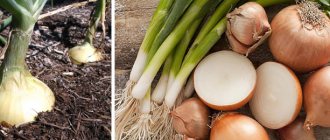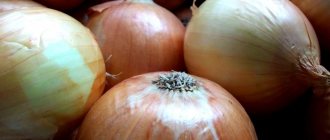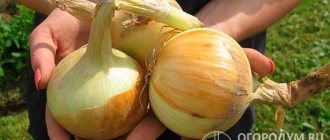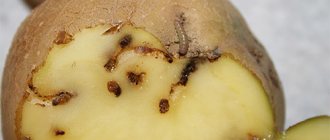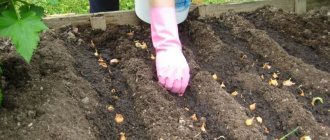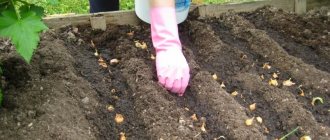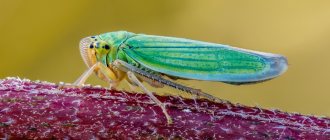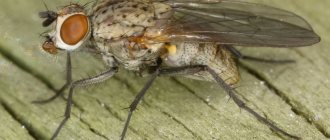Onion fly
If your onion plantings begin to gradually fade, its leaves turn yellow, and the bulbs are completely rotten, you should take a closer look - most likely, an onion fly has settled somewhere nearby.
The onion fly is the biggest fan of the burning vegetable, and therefore you need to fight it seriously and decisively. But it’s not so easy to notice this pest: this small (6-8 mm) yellow-gray or ash-gray insect is very similar to the most common house fly. But even this pest can be fought, and quite successfully.
Measures to combat onion fly
You will always have time to fill your garden with chemical poison. Start with less drastic measures:
- for prevention purposes, before the onion fly attacks, spray the beds with infusions of mint, valerian, pine needles, fir, tomatoes or wild rosemary (the pest cannot stand the smell of these plants);
- alternate planting onions and carrots (the onion fly does not tolerate the carrot aroma);
- sprinkle the beds with onions with ash (ash will not only repel the pest, but will also serve as an excellent fertilizer for the soil);
- water the beds with a solution of table salt;
- observe crop rotation (take a break from planting onions for 3-4 years);
- Soak onion sets in a solution of potassium permanganate before planting;
- in the fall, dig the soil deeply (to a depth of at least 25 cm);
- every 4 days, loosen the soil around the bulbs (the onion fly does not like to lay eggs in loose soil);
- Mulch the onion plantings with peat or dry, semi-rotted manure.
The first time the beds are treated with a solution of table salt, when the onion sprouts reach a height of 5 cm (300 g of salt per bucket of water). The second treatment is carried out after another 2-3 weeks (450 g per 10 liters of water). The third - after another 3 weeks (600 g per 10 l).
If the onion fly did not understand your transparent hints in the form of non-chemical measures, it’s time to move on to the “heavy artillery”. A number of chemicals can help you in this battle for the harvest: Aktara, Alatar, Fly-eater and many others.
You need to know the enemy by sight
Incredibly, hot and bitter onions are a very tasty vegetable for a number of insects. But this is not very pleasant for gardeners, since voracious pests can destroy the entire crop. In addition to pests, you need to know the diseases of onions and their treatment, since insects are the first to attack diseased plants.
Among the most malicious and dangerous insects is the onion fly.
Onion fly
Lilacs, cherries and dandelions have bloomed, which means it’s time for the mass flight of the onion fly. This insect is found in all regions of Russia and the damage it causes to onions is serious. Inconspicuous ash-gray flies hurry to the onion beds, where they lay eggs in the inter-rows near the newly emerging sprouts. About a week passes and the emerging fly larvae begin to colonize the plants, eat young shoots, penetrating into the base of the nascent bulb.
ON A NOTE! Nigella onion crops, where the distances between seedlings are minimal, are especially quickly affected by pests.
Young plants, after being damaged by larvae, immediately begin to wither; in older plants, the bulb and feather are damaged. The tubular leaves turn yellow, the bulb softens, rots, and near such beds a sharp, unpleasant smell of rot is felt (see photo). If the bulb is pulled out of the soil, you can see white worms crawling inside the pulp. The plant may die even if it is damaged by only one or two larvae, but usually there is a massive attack, since the period of egg laying by flies lasts up to one and a half months.
After about three weeks, the larvae themselves penetrate the soil and pupate. In one summer season, usually two develop, and under favorable conditions (in the south, where summers are longer), there may even be three generations of onion flies.
Stem nematode
From about mid-July, onions can be attacked by a very dangerous pest - stem nematode. This is a small worm that infects the leaves of the plant and then the bulbs. Eel nematodes cause enormous damage to the plantings of many plants, including not only onions, but also garlic, radishes, cucumbers, and bulbous flowers.
The nematode penetrates inside through the onion feather, and can also enter the bulb through the bottom. It is very difficult to remove it, especially since the pest can fall into a state of suspended animation and exist like that for a number of years.
How do you know if an onion is infected with a nematode? The leaves of the plants begin to change color, lighten, and then curl. Characteristic swellings may appear on the surface, and then the feather withers and dries up. The bulbs of such plants begin to rot.
The nematode overwinters on the remains of vegetation, and can also enter vegetable storage through damaged bulbs.
Onion weevil
This small bug got its name from the presence of a proboscis bent downwards, hence its second name - secretive proboscis. Onions are damaged by weevil larvae, laid by females in early spring. Yellow larvae are very voracious, and if proper measures are not taken, they can destroy all the green feathers of plants.
On one onion bush, up to 15 larvae can hatch from laid eggs, which eat the inner juicy pulp of onion feathers. Because of this, plant leaves begin to turn yellow (especially the tops), curl, and dry out. The feather has characteristic whitish stripes. Next, the grown larvae penetrate through the bulbs into the soil, where they pupate.
Adult beetles also feed on the juice of the leaf pulp, piercing their surface with their proboscis. The weevil causes especially great harm to plants sown with nigella.
Onion moth
If the summer is hot and dry, onions can be bothered by onion moths. Not particularly noticeable, with brown wings, butterflies lay eggs on the feathers of onions, flower shoots or on bulbs. Laying time is in June. After a week, very voracious worms appear, which eat away the inside of the onion leaves, leaving the thin skin completely intact. Also, moth larvae penetrate flower stalks, bulbs, and the turnip neck, making whole labyrinths of passages.
After this, the caterpillars pupate and after about 14-16 days the butterflies appear again. The cycle begins anew, and over the entire summer season this pest can produce two, three, or even four generations.
The leaves of damaged plants turn yellow, wither, dry out, and the bulbs rot.
Onion hoverfly
A rather large bronze-green fly, the hoverfly, poses a great danger to onions. Its larvae, gray worms with green spots, feed on the pulp of juicy turnips.
Typically, female hoverflies lay eggs in small clusters, choosing for this purpose weak, diseased, and also plants infected with other pests. Onions that are damaged by the hoverfly begin to rot the bulbs, the process of decomposition quickly proceeds and the vegetable dies.
The larvae of harmful insects can overwinter excellently on turnips that remain in the ground in the beds; they are also successfully preserved in storage facilities and onion pantries. After wintering, the larvae turn into pupae, then with the arrival of summer days new flies fly out.
ON A NOTE!
This pest is very dangerous, since outwardly the plants may look quite healthy. The feeding of the feathers for some time comes from the reserves of the bulb, and only in the second half of summer can a completely rotten turnip be discovered.
During the summer season, two generations of hoverflies usually develop.
Root mite
Many bulbous plants, including the beloved onion, can be threatened by the tiny onion mite. For his settlement, he chooses weakened plants, and then gradually switches to healthy, strong onions.
The optimal living conditions for the onion mite are heat and high humidity. Fertile female insects lay up to 350 eggs in one clutch, from which larvae then hatch. Mites feed on the internal scales of the turnip, sucking out all the juices and turning the bulb pulp into dust.
The root mite devours the onion, and the leaves begin to wither, become covered with whitish spots, and curl. When the temperature drops, the life of the insect seems to freeze, and as soon as it gets warmer, reproduction continues again.
Insects quickly move onto healthy plants, damaging plantings on a large scale.
Thrips
These tiny insects, which are no more than 1.5 mm long, are difficult to notice, so gardeners often find out that the onion is seriously damaged too late.
The damage is caused by small larvae, which in the first period of their existence eat the pulp of leaves and bulbs. How do you know if thrips have appeared on onion plants? Firstly, whitish stripes become visible on the feathers of the onion. Secondly, the larvae leave numerous feces in the form of clusters of black dots on the leaf. Next, the onions themselves become deformed, the scales of which begin to dry.
You may be interested in: Dates for planting leeks for seedlings in 2022 throughout Russia Dates for planting onion sets in 2022 for feathers and turnips in different regions of Russia Harvesting onions according to the lunar calendar 2022 in Siberia
Thrips larvae overwinter between dry scales of bulbs stored for storage. At the same time, the quality of the turnips decreases, and the planting material becomes unsuitable for growing in the spring.
Aphid
Various types of aphids infect many garden crops; onions are no exception in this case. Basically, aphids settle on shallots, hence its name - shallots, but onions also come under attack.
The pest is found on young onion leaves and also makes its way under the outer scales of the turnip. The feather of such an onion begins to lag in growth, bend, and wither. A large amount of aphid skins (due to molting), as well as honeydew, remain on the surface of the tubular leaves. This feather should not be eaten.
Aphids cause the greatest harm to young plants, as well as to onions that are planted in greenhouses to force feathers. The insect overwinters either in greenhouses or in vegetable stores.
Onion hoverfly
Bronze-green, with light gray stripes on its back, the onion hoverfly literally steps on the heels of its predecessor, the onion fly, trying to snatch primacy among onion pests from its thin legs. This small insect (up to 9 mm) spoils not only onion plantings in the beds, but also forced onions standing on your window. An extremely harmful individual, isn't it? Therefore, it is important to notice it in time: the first sign is yellowing onion leaves. The sad outcome is rotting of the bulbs.
The onion hoverfly's flight begins with the beginning of rosehip flowering.
Measures to combat onion hoverfly
Experienced gardeners carry out a number of activities that help eliminate the onion hoverfly. They know for sure that it is not at all necessary to immediately grab onto “chemistry” - first you need to use “folk” means of struggle.
- carry out autumn digging, thereby destroying the pest larvae;
- pre-soak the planting material in a solution of potassium permanganate (this will destroy the pest larvae that may be in the seedlings);
- plant carrots next to the onions (it will repel not only the onion fly, but also the onion hoverfly);
- observe crop rotation, maintaining a break of 3-4 years before returning the onions to their original place;
- Early planting of onions can also provide protection against pest attacks;
- to repel the onion hoverfly, pollinate the plantings every week with lime, mothballs, ash, tobacco dust or ground pepper;
- mulch the beds with chopped spruce branches, rotted manure and peat.
To speed up the growth of onions and reduce the likelihood of damage to the plantings by the onion hoverfly, use 3 liters of urea solution per 1 sq.m of bed (1 tbsp urea per 10 liters of water).
Onion (tobacco) thrips
Have you noticed whitish or silvery spots on the leaves of the onion (sometimes they can even merge), the leaves have turned yellow, bent and dried out? Most likely, the juice was sucked out of them by onion (tobacco) thrips.
You can recognize this pest (although it is extremely difficult to notice) by several signs:
- small size (0.8-0.9 mm);
- the insect is narrow and oblong;
- onion thrips have fringed wings;
- The color of the insect is light yellow or dark brown.
Onion thrips mainly damages plantings in greenhouses and greenhouses, but can attack bulbs in open ground, as well as damage them during storage.
Measures to combat onion (tobacco) thrips
A number of timely measures will help you avoid meeting the onion “bloodsucker”. Every gardener simply must know how to protect his plantings from this scourge.
- observe crop rotation;
- Disinfect planting material before planting in hot water (about 45ºС) for 10 minutes, and then cool it in cold water;
- soak the planting material in a 2% solution of sodium nitrate for 24 hours;
- be sure to dry the onions after harvesting at a temperature of 35-37ºС for 5-7 days;
- after harvesting, destroy all plant debris;
- carry out deep autumn digging of the soil (to a depth of more than 25 cm).
Weevils on onions
The insect damages onion leaves by sticking its long proboscis into them, which is why it got its name. Because of this, the feather begins to dry out, turns yellow and curls. Small light spots may also appear on it, harbingers that the greens will soon begin to deteriorate.
You can prevent onion spoilage by watering the soil with an infusion of ash, celandine or potato tops from late spring until July.
Onion root mite
First, the bottom of the onion cracks and becomes a rotten mass, then the fleshy scales of the onion are damaged, and finally, the onions soften and rot. If your crop has become like this, know that it was damaged by the onion root mite.
It is incredibly difficult to notice this pest, because its length is only 0.7-1.1 mm. It’s simply amazing how this miniature oval insect with a glassy body and 8 legs can harm plantings on which so much time and effort have been spent.
Measures to combat onion root mite
Do you want to get rid of the small but very harmful onion root mite? Just follow our simple tips.
- observe crop rotation;
- warm up the planting material in hot water (45ºС) for 10 minutes;
- try to harvest onions in dry weather, and after harvesting, dry them for 5-7 days at a temperature of 35-37ºС or for 8-10 days at a temperature of 30-35ºС;
- store the sets mixed with dry chalk;
- destroy all plant debris immediately after harvesting;
- dig the soil deeply (more than 25 cm).
Chemical insecticides for pest control of onions and garlic
| Name of insecticide | Pest against which treatment is carried out | Consumption rate of the drug (kg/ha, l/ha) | Packaging |
| Aktara 25 WG, v.g. (thiamethoxam, 250 g/l) | Onion fly, tobacco thrips, onion secretive proboscis, hoverfly, leaf beetle (rattler) | 0,2-0,4 | 1.4 g, 6 g, 250 g |
| Apollo c.s. (clofentizine, 500 g/l) | Onion mite | 0,3-0,5 | 1 l, 5 l |
| Bi-58 new, k.e. (dimethoate, 400 g/l) | Ticks, thrips | 0,5-1,0 | 1 l, 5 l, 10 l |
| Vertimek 018 EC k.e. (abamectin, 18 g/l) | Thrips, spider mite | 0,8-1,2 | 10 ml, 100 ml, 1 l |
| Decis f-lux 25 EU, k.e. (deltamethrin, 25 g/kg) | Thrips, onion fly, onion hoverfly, onion muskellunge | 0,2-0,3 | 5 l |
| Exirel, S.E. (cyantranilprole, 100 g/l) | Thrips, onion fly | 0,75-1,0 | 250 ml, 1 l |
| Enzhio 247 SC, k.s. (lambda-cyhalothrin, 160 g/l + thiamethoxam, 141 g/l) | Onion fly, thrips | 0,18 | 3.6 ml, 100 ml, 5 l |
| Karate Zeon 050 EU, k.e. (lambda-cyhalotron, 50 g/l) | Onion fly | 0,15-0,4 | 5 l |
| Pirinex Super, k.e. (chlorpyrifos, 400 g/l + bifenthrin, 20 g/l) | Onion root mite | 0,8 | 1 l, 5 l |
| Movento k.s. (spirotetramat, 100 g/l) | Thrips | 0,75-1,0 | 1 l |
| Mospilan, v.p. (acetamiprid, 200 g/kg) | Onion cracker | 0,2-0,3 | 50 g, 0.2 kg, 0.4 kg, 1 kg |
| Commander, r.k. (imidacloprid, 200 g/l) | Onion cracker, thrips | 0,1 | 1 l |
| Lannat v.r. (methomyl, 200 g/l) | Tobacco onion thrips | 0,8-1,2 | 1 l, 5 l |
| Nissan, sp. (hexythiazox, 100 g/kg) | Onion root mite | 0,4-0,5 | 0.5 kg |
| Nurel D, Ph.D. (chlorpyrifos, 500 g/l+cypenrmethrin, 50 g/l) | Thrips, onion fly | 0,8-1,2 | 7 ml, 5 l |
| Ratibor, v.r.k. (imidacloprid, 200 g/l) | Onion fly | 0,25-0,3 | 4 ml, 10 ml |
| Fastak, Ph.D. (alpha-cypermethrin, 100 g/l) | Onion moth, onion thrips | 0,1-0,15 | 1 l |
If you find an error, please select a piece of text and press Ctrl+Enter.
Onion moth
Moths can significantly damage not only fur coats and fur hats. If you notice gnawed-out windows of pulp on onion leaves with the outer skin intact and after that the leaves have dried out, it means that a real onion moth has settled on your plantings.
It is easy to recognize this pest: these dark brown butterflies with a wingspan of up to 10 mm are visible to the naked eye. And the yellowish-green caterpillars of the onion moth with longitudinal stripes and spots are not so easy to hide - their length reaches 4 cm.
The onion moth not only injures the leaves of the stinging plant, but also penetrates the set, gnaws the stalks of the testes and eats away the rudiments of the flowers.
Measures to combat onion moth
The onion moth is unlikely to take a liking to healthy and well-groomed plants, and therefore the primary tasks of an attentive gardener should be:
- loosening the beds;
- weeding;
- timely feeding of onions.
Gnawing (cotton) bollworm
The gnawing armyworm is dangerous only in the form of a caterpillar. An adult cutworm looks like a large light brown moth. When the wings are folded, a V-shaped spot is formed on the back. The butterfly lays single creamy-white eggs. Larvae emerge from them, which degenerate into brown or greenish caterpillars. It is at this stage of life that the cutting armyworm causes the most problems for gardeners.
The larvae are usually located inside the stem, but subsequently (during the transition to the next life stage), they begin to move closer to the soil. The caterpillar burrows into the soil and begins to chew through the white flesh of the onion. As a result, the green stems dry out completely, and the vegetable itself becomes unsuitable for consumption. To get rid of the gnawing armyworm, you can use the same insecticides that are used against thrips.
Careful cultivation of the topsoil is also recommended. Regular loosening of black soil creates unfavorable conditions for the laying and normal development of eggs. If only root crops are planted at your summer cottage, then you can hang several feeders on the surrounding trees. This is the most natural and inexpensive method of getting rid of pests. Cutworm caterpillars are the best treat for birds.
Stem onion nematode
If the bulbs you carefully cultivated have become loose, “turned out”, and their leaves have become brittle and twisted, start fighting the next onion “gourmet” - the onion stem nematode.
This pest has nothing to hide: it is incredibly difficult to see a white thread-like worm with a length of only 1-1.5 mm with the naked eye.
Methods of combating stem onion nematode
To get rid of the stem onion nematode, you will have to try. But do you want to win an unconditional victory in this fight?
- Plant onions or garlic on the infected area no earlier than after 5 years;
- select healthy seed;
- disinfect onion sets at a temperature of 45-46ºС for about 10-15 minutes, at a temperature of 50-52ºС - for 5-10 minutes, at a temperature of 55-57ºС - for 3-5 minutes;
- if the bulbs are very small, then disinfect them at a temperature of 45-46ºС;
- if the bulbs are slightly infected, then keep them in water at a temperature of only 40ºC for 2 hours;
- After harvesting, be sure to remove all plant debris.
Signs of pest damage
It can be difficult to recognize pests on onions, since the feathers of the crop are thin and the heads are more than half hidden underground. Adult insects and larvae are often invisible to the naked eye. But indirect signs help to recognize their presence:
- premature yellowing and fading of feathers;
- the appearance of dark spots and holes on green leaves;
- slowing down the growth of onions;
- decrease in yield;
- the appearance of plaque on feathers and bulbs.
A ripe crop damaged by insects is not of good quality. The onion heads turn out to be small, rotten or dried out. On the bottom and roots you can often notice accumulations of larvae and adult insects.
Onion sneaker
Have you noticed white spots on onion leaves? Or maybe these are not spots at all, but cavities eaten away from the inside of the leaf! Most likely, a real pest, the onion secretive proboscis, has opened its mouth (or, to be precise, its proboscis) on your harvest.
The beetle itself is only 2.2-2.5 mm long, but the damage caused by it is very noticeable. This small black bug has whitish scales on its body, which is why it may appear gray. Its distinctive feature is a thin, long rostrum bent under the chest. Actually, this is exactly what this pest uses.
Measures to combat the onion secretive proboscis
The fight against this insect can be successfully carried out using the most common agricultural methods:
- trim and destroy affected plant leaves;
- observe the norms and timing of watering and fertilizing the plantings;
- loosen the soil around the onions to prevent the larvae from pupating;
- After harvesting, be sure to destroy all plant debris.
Onion pests can cause irreparable harm to your harvest, destroying it completely, leaving you without supplies for the winter. But this will only happen if you remain inactive or capitulate, voluntarily abandoning a possible fight. If you use our advice, be sure that you will be the winner in this battle!
